The stories of war never cease to amaze. Whether they are gruesome tales of heroism and sacrifice, amazing discoveries, terrible wrongdoing, or of simple humanity shining through the difficult times. Stories of the war front are often just as potent and intriguing. And there are many tails of the war front that will raise eyebrows and take people back to a time where patriotism and love of country not only permeated the streets but also mobilized in tangible ways while soldiers were out in battle. So we thought we’d take a look at a mysterious story about iron railings in London during the war, as well as other like-minded war efforts.
So there is apparently quite a bit of controversy regarding the story of the London railings. There are different schools of thought as to whether it actually happened and as to what actually became of the iron railings that were uprooted. And yet, the story remains quite contented and in 2012, an artist named Catalina Pollak created an installation titled Phantom Railings in Malet Street Gardens London to commemorate the alleged disappearance and legacy of these iron railings.
It goes without saying that London and a lot of Britain heavily utilized the wrought iron and iron railings prior to World War II. During the early 20th century and even back to the Gothic period, England saw a lot of wrought iron work in its cities, parks, and surrounding government buildings and estates. So an on any given day, if you took a walk across the city of London, you would likely come across many iron railings that surrounded homes, parks, and more.
So let’s take a step back. What’s with the railings?
So during the war, resources were scarce. People living back in Britain and in America, for example, had to make considerable sacrifices and rationing in order to keep the war machine as the top priority. There were several campaigns spearheaded by Allied governments that asked the people at home to collect, ration, and donate. This includes everything that was metal to even food items like milk and flour.
One of the stories goes that people went and tore down iron railings and fences around London in order to collect scrap metal needed for the war effort. This was all part of a national scrap drive that asked people to send in scrap metal in order that it could be processed into necessary material for weapons, aircraft, and more. There are pictures that show people tearing down these wrought iron fences. Some stories suggest, however, that said the metal could not be used —for a variety of reasons— and was then dumped in the Thames or used for ballast for ships in the Port of London. This seems to be a prevailing theory, as many contend that the scrap metal was not able to be processed into weapons of war. Some would add that dockers in Canning Town 1978 reported working on these ‘lighters’ during the time and claimed that there was in fact a lot of ornamental iron railings dumped into the Thames estuary.
There is no doubt that many railings were removed in London, as the remnants and metal nubs remain in place. What they were used for and where they ended up is another question all together. Some say some railings were removed from many garden squares to make them accessible to the public.
While no one can seem to say for sure what happened to 100% of these railings, there are several possibilities. One thing that is true, is that anytime there were these kinds of calls to actions for the British and even American public, it was a unifying effort to boost morale at home. Back in the United States, housewives and family members were collecting pots, pans, and anything aluminum they can get their hands on and taking it to the stockpiles in order that it might be used for the war effort. It’s even said that communities melted down old Civil War cannons and tore down historical wrought iron fences in order to help the ‘boys overseas.’ So one school of thought says that even when authorities were aware they couldn’t use much of this scrap metal, they held back in calling off the scrap metal drive, as it had proven to be a great unifier for people back home.
Atrium Wrought Iron Does Classic to Modern Iron Designs
So whether you love the classic and more gothic-inspired style wrought iron gates, or looking for something a little more sleek and modern, we can do it all. Iron railings are robust, strong, and long-lasting. They inspire a kind of authority and beauty that is timeless and stylish. Whether you are looking at it for your home or business, call an iron expert you trust. Call Atrium Wrought Iron today.








Leave A Comment